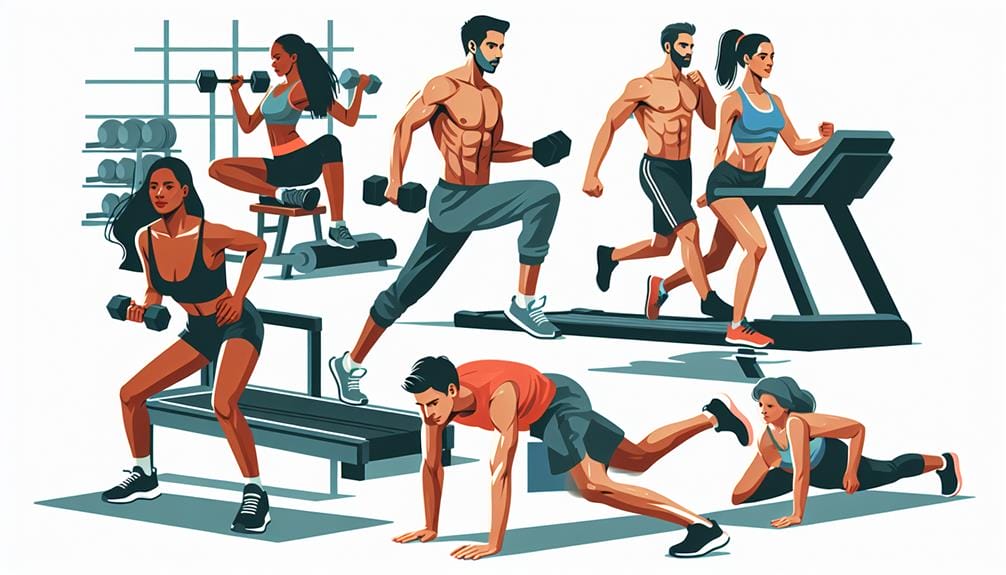A full-body workout plan maximizes strength and endurance by targeting multiple muscle groups in each session. Start with a dynamic warm-up to increase heart rate and blood flow. Incorporate essential equipment like dumbbells and a versatile box for exercises such as lunges and step-ups. Focus on compound strength movements to save time and effort, ensuring proper form. Engage your core to stabilize the spine and prevent injuries. Aim for three sessions weekly, allowing for muscle recovery. Track your progress with a journal or app. Prioritize nutrition with adequate protein, carbohydrates, and hydration. If you follow these steps, you'll see significant gains.
Key Takeaways
- Engage in efficient full-body workouts with compound exercises to build strength and boost endurance.
- Incorporate essential equipment like dumbbells, BikeErg, and boxes to target various muscle groups effectively.
- Follow a balanced workout plan with three sessions per week, allowing for muscle recovery.
- Prioritize dynamic stretching and cardiovascular techniques during warm-ups to enhance performance and reduce injury risk.
- Track progress with a journal or app, adjusting intensity and volume based on strength and endurance improvements.
Benefits of Full-Body Workouts
Full-body workouts offer a holistic approach to functional fitness gains and performance enhancement, engaging multiple muscle groups in a single session. This makes your exercise routine both efficient and effective, helping you build strength, boost endurance, and achieve balanced muscle development.
Imagine lifting groceries with the same ease as lifting a feather—full-body workouts can make that a reality. They target major and minor muscle groups simultaneously, ensuring no muscle feels left out. Plus, they're great for improving muscle coordination, so you'll stop tripping over your own feet.
Essential Equipment

To get the most out of your full-body workout plan, you'll need essential equipment like dumbbells, a BikeErg, and a versatile box. Dumbbells are perfect for exercises like weighted step-ups and lunges, making you feel like a superhero in training.
The BikeErg? It's your ticket to cardio heaven, enhancing endurance and burning calories faster than you can say 'cheat day.'
And the box? It's not just for Amazon deliveries; it's great for step-ups and can be swapped out with a stable chair or small table if you're working out at home.
With these tools, you'll target different muscle groups effectively and ensure a well-rounded workout. So, gear up and get moving!
Warm-Up Routine
Before starting your full-body workout, it's important to engage in a warm-up routine that includes dynamic stretching exercises and cardiovascular techniques.
Movements like arm circles, leg swings, and light jogging will increase your heart rate and blood flow, preparing your muscles and joints for exercise.
Spending just 5-10 minutes on this routine can greatly enhance your performance and reduce the risk of injury.
Dynamic Stretching Exercises
Dynamic stretching exercises are an essential part of warming up as they get your muscles ready and boost blood flow for an effective workout. Think of it as the pre-party before the actual party.
By incorporating dynamic stretching in your warm-up, you'll improve flexibility and range of motion, ensuring you're all set to rock that workout. Picture yourself doing leg swings, arm circles, lunges with a twist, and high knees. These moves aren't just fun; they also help prevent injuries.
Cardiovascular Warm-Up Techniques
After getting limber with dynamic stretching, it's time to elevate your heart rate with some effective cardiovascular warm-up techniques. Think of this as revving your engine before a race.
Jumping jacks, high knees, and arm circles are your go-to moves for a dynamic warm-up that gets the blood pumping. But hey, if you're not up for a high-impact dance party, low-impact cardio exercises like marching in place or side shuffles work wonders too.
These moves not only boost your heart rate but also prepare your muscles for action, reducing the risk of injury. Aim for a well-rounded warm-up lasting 10-15 minutes, targeting major muscle groups to enhance flexibility and mobility.
Ready, set, warm-up!
Strength Movements

Strength movements like deadlifts, squats, bench presses, and rows are fundamental for engaging multiple muscle groups and building overall strength effectively. These compound exercises are your best friends in the gym, working several muscles at once, saving you time and effort.
But don't get cocky—proper form is essential. Nobody wants to see you doing the 'wobble squat.' Incorporate ramped sets like 5×5 and 3×5 to gradually increase the weight, optimizing muscle engagement and strength development. This way, you're not just lifting heavy; you're lifting smart.
Cardio Intervals

Cardio intervals, particularly High-Intensity Interval Training (HIIT), are a powerful addition to any workout plan. They alternate between bursts of high-intensity exercise and periods of low-intensity recovery, boosting metabolism and improving cardiovascular fitness.
For those looking for a gentler approach, low-impact cardio options still offer effective ways to enhance endurance and burn calories.
High-Intensity Interval Training
High-Intensity Interval Training (HIIT) is a powerful way to elevate your cardiovascular fitness and burn calories in a shorter amount of time. Picture this: you're sprinting like you stole something, then catching your breath just long enough to do it all over again. This alternating between intense bursts and short recovery periods not only boosts your cardiovascular fitness but also cranks up your metabolism.
Studies show HIIT increases oxygen consumption and improves insulin sensitivity, making it a triple threat! Plus, you can tailor HIIT to match your fitness level and goals, so no excuses!
Low-Impact Cardio Options
While HIIT is a fantastic way to push your limits, incorporating low-impact cardio options into your routine can offer a gentler yet effective way to boost endurance and cardiovascular health.
Think biking, swimming, or rowing; these activities are like giving your joints a spa day.
Cardio intervals, where you alternate between high and low intensity, can seriously up your fitness game without making your knees scream for mercy.
Whether you're dealing with joint issues or recovering from an injury, low-impact cardio keeps you moving without excessive strain.
Plus, it's a great excuse to avoid those burpees for a while.
Core Exercises

Incorporating core exercises into your workout routine is essential for stabilizing the spine and enhancing overall strength. Think of your core as the unsung hero of strength gains.
You'd be amazed at what planks, Russian twists, and bicycle crunches can do. But don't just stick to the same old reps—embrace progressive overload. Increase those reps, add some resistance, and watch your core turn into a fortress.
A strong core isn't just for show; it helps prevent injuries and boosts athletic performance. Plus, strong abs mean less wobbling during those TikTok dance challenges.
Cool-Down Routine
After your workout, it's essential to engage in a cool-down routine to gradually lower your heart rate and ease your muscles into recovery mode.
Start with stretching exercises that target the muscles you've just worked to help reduce soreness and improve flexibility.
Incorporate deep breathing and relaxation techniques to enhance circulation and promote overall muscle recovery.
Stretching for Muscle Recovery
A proper stretching routine post-workout speeds up muscle recovery and boosts flexibility. You'll thank yourself later when you're not hobbling around like a pirate.
Stretching helps reduce that dreaded muscle soreness and stiffness after an intense session, making it easier to move the next day. It also improves circulation and range of motion, so you can show off your limber moves.
Target the specific muscles you worked out to guarantee maximum recovery. Consistent post-workout stretching can enhance your overall athletic performance and keep injuries at bay.
Breathing and Relaxation Techniques
To wrap up your workout, focus on breathing and relaxation techniques that can greatly enhance your recovery. Picture yourself as a zen master, breathing techniques in hand, ready to conquer the cool-down routine. Try diaphragmatic breathing—it's just a fancy term for belly breathing—to lower your heart rate.
Inhale deeply, let your belly rise, and exhale fully. Feel like a balloon? Great! Next, progressive muscle relaxation will help you release tension, one muscle group at a time. Don't forget mindfulness! Imagine your stress melting away like ice cream on a hot day.
Weekly Schedule

Crafting an effective weekly schedule for your full-body workout plan guarantees you hit all major muscle groups while allowing adequate time for recovery. Aim for three workout sessions a week, ideally spaced out to give your muscles time to breathe—because nobody wants to walk like a zombie.
Incorporate weight training to target both major and minor muscle groups. You might do a Monday-Wednesday-Friday split, giving you those sweet rest periods in between. Beginners and advanced lifters alike benefit from this setup.
Progress Tracking
Monitoring your progress is essential for understanding how your strength and endurance improve over time. Grab a workout journal or app and start logging your sets, reps, weights, and rest periods. Think of it as your fitness diary—minus the teenage angst.
Record personal records like max weight lifted or longest plank held. Tracking metrics such as body measurements and workout duration provides a clear picture of your gains. Consistent progress tracking isn't just about bragging rights; it helps you adjust training intensity, volume, and frequency for best results.
Nutrition Tips

Now that you're tracking your progress, let's talk about how proper nutrition fuels those gains. First, prioritize protein intake; it's essential for muscle repair and growth. Think of it as the bricks to your muscle-building house. Carbohydrates are equally important—they're your energy source, keeping you fueled for those intense workouts. And don't forget fats; they support hormone production and overall health. Finally, hydration is vital. Without enough water, your body won't perform at its best.
Here's a quick reference table:
| Nutrient | Role | Source |
|---|---|---|
| Protein | Muscle repair and growth | Chicken, tofu, beans |
| Carbohydrates | Energy and glycogen replenishment | Brown rice, oats, fruits |
| Fats | Hormone production, overall health | Avocado, nuts, olive oil |
| Water | Hydration, performance, recovery | Drink, drink, drink! |
Common Mistakes

One of the biggest mistakes in a full-body workout plan is neglecting proper warm-up and cool-down routines. Skipping these can turn you into a human pretzel faster than you can say 'ouch.'
Overtraining certain muscle groups while ignoring others can create imbalances, making you look like a lopsided superhero. Failing to adjust your weights and progressions is like trying to run a marathon in flip-flops—not very effective.
Also, poor form and technique can transform your workout from muscle-building to injury-inducing. Let's not forget, ignoring rest and recovery can leave you feeling like a zombie.
Advanced Variations

Advanced variations in a full-body workout can elevate your fitness routine by incorporating complex movements, explosive exercises, and unique equipment. Spice things up with power cleans to build strength and coordination or jump into plyometric exercises like box jumps to boost power and agility.
Don't forget unilateral movements such as Bulgarian split squats to improve balance and stability—trust me, your core will thank you. Isometric holds like planks can also supercharge your endurance.
Want more fun? Throw in some resistance bands, kettlebells, or suspension trainers to keep your muscles guessing. These advanced variations won't only make your workouts more challenging but also keep you engaged and motivated.
Ready to level up? Get moving!
Conclusion
Wrapping up your full-body workout plan is like putting the final brushstrokes on a masterpiece. You've learned the benefits, gathered essential equipment, and mastered a warm-up routine.
By combining strength movements and cardio intervals, you're building a balanced, powerful body. Track your progress, fuel your body with proper nutrition, and avoid common mistakes.
Once you're comfortable, try advanced variations to keep challenging yourself. Stick to this plan, and you'll see significant improvements in both strength and endurance.





Leave a Comment